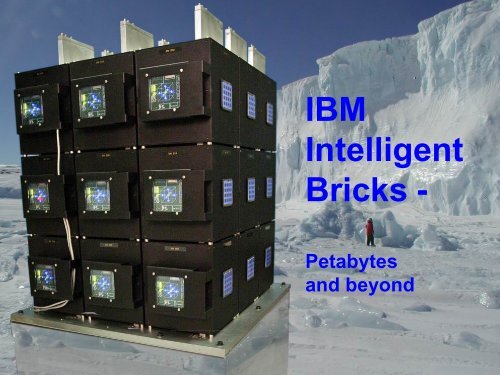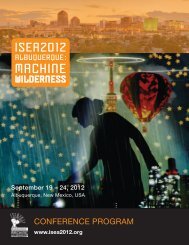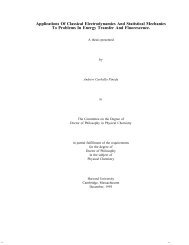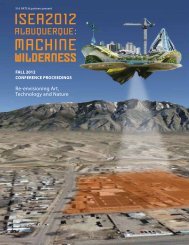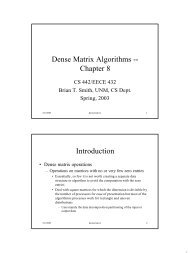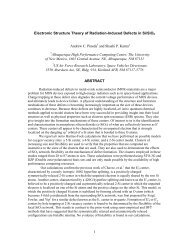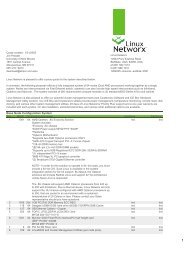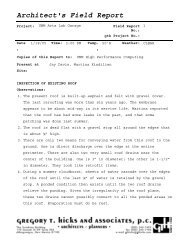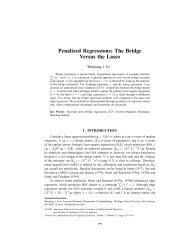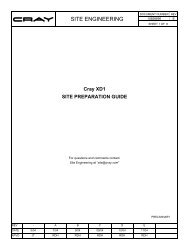IBM Intelligent Bricks - - UNM Center for Advanced Research ...
IBM Intelligent Bricks - - UNM Center for Advanced Research ...
IBM Intelligent Bricks - - UNM Center for Advanced Research ...
Create successful ePaper yourself
Turn your PDF publications into a flip-book with our unique Google optimized e-Paper software.
Project Scope• IceCube/Kybos or “<strong>Intelligent</strong> <strong>Bricks</strong>” project <strong>for</strong>mally originatedin <strong>IBM</strong> Almaden in 2001– Collaboration between <strong>IBM</strong>’s Almaden <strong>Research</strong>, Yorktown CSS, E&TS(Mainz), and ~ 20 external vendors• It is a research project, not an <strong>IBM</strong> product• It’s all about ‘Brick-based’ architectures– It’s not just about cool hardware !– Integrates several new ideas in system hardware, software,communications technology, scalability, reliability and managementinterface designARC External Website, <strong>Intelligent</strong> <strong>Bricks</strong>, 2005
Team Members• Winfried W. Wilcke, Claudio Fleiner, Robert Garner,, RichardGoulding, Jody Glider, Deepak Kenchammanna-Hosekote, TedWong, Ralph Becker-Szenday, Omer Zaki, K.K. Rao, Jim Hafner,Manny Hernandez, Ken Fernandez, Moidin Mohiuddin, (<strong>IBM</strong>Almaden Res.)• Harald Huels, Klaus Smolin, Manfred Ries, Heinz Lenke, GabyPersch-Schuy (<strong>IBM</strong> E&TS Mainz)• Barry Rubin, Tom Picunko, Vincent Arena (<strong>IBM</strong> Watson Res.)ARC External Website, <strong>Intelligent</strong> <strong>Bricks</strong>, 2005
Storage Enterprise Customer’s Top Issues• Easier System Management => reduced Total Cost of Ownership• Better Scalability - but at low cost• Better Environmentals– floor space, power, cooling and noise• Better Reliability and Availability• Goal: Order-of-Magnitude Improvements…ARC External Website, <strong>Intelligent</strong> <strong>Bricks</strong>, 2005
How much (unique) In<strong>for</strong>mation ? (2002)• Gigabyte => Terabyte => Petabyte => Exabyte => Zetabyte =Yottabyte10 9 10 12 10 15 10 18 10 21 10 24• Worldwide phone calls: 17.3 Exabytes (15% wireless)• Radio & TV new programs 3.5 & 69 Petabytes, resp.• E-mails per year 400 Petabytes (11 PB in ’99)• New Home Videos per year: 2600 Petabytes ( 400 PB in ’99)• Office Documents per year: 195 Petabytes (’99)• World Wide Web (surface) 170 Terabytes• World Wide Web (deep) 80 Petabytes• Medical images (digital , USA) 80 PetabytesIn 2003, 5 Exabytes of unique new in<strong>for</strong>mation was created ** Source: UC Berkeley School of In<strong>for</strong>mation Mgt. Systems Study etalARC External Website, <strong>Intelligent</strong> <strong>Bricks</strong>, 2005
ARC External Website, <strong>Intelligent</strong> <strong>Bricks</strong>, 2005Keep things as simpleas possible(but not simpler)
Zen of Simplicity• Be transparent – no surprises– Give a coherent mental model of how the thing works• Restraint– Cut non-essential features• Modularity• Encapsulate unavoidable complexity=> Small number of building block typesARC External Website, <strong>Intelligent</strong> <strong>Bricks</strong>, 2005
Brick Architectures <strong>for</strong> Simplicity (1)• Encapsulate hardware into Lego-like bricks– Each brick contributes to processing, storage, & networking• Small number of brick types– That is very different from today, where disks, controllers, switches etcall are different (field replacable and customer visible) partsARC External Website, <strong>Intelligent</strong> <strong>Bricks</strong>, 2005
Brick Architectures <strong>for</strong> Simplicity (2)• Long-lived, public interfaces– Network protocol, Physical, Interfaces,– Careful architecture work required to define ‘families’ of interoperablebricks and relations between families• <strong>Bricks</strong> should be low cost (use commodity components)– Minimize redundancy within a brick– Deal with failures at a higher, system level• Any brick must be allowed to fail without noticeably impactingsystem operation, as long as ‘most’ of the bricks are alive– System software must deal with and hide the failure– “Fail-in-place’ a natural extensionARC External Website, <strong>Intelligent</strong> <strong>Bricks</strong>, 2005
Generic 3-D BrickNo connectors, fans, cables, fibers, lasers...Commodity components @ low costHeat (out)Power (in)Communications(in,out)zyxARC External Website, <strong>Intelligent</strong> <strong>Bricks</strong>, 2005
<strong>Intelligent</strong> <strong>Bricks</strong>: PrototypeARC External Website, <strong>Intelligent</strong> <strong>Bricks</strong>, 2005
Storage Brick - Prototype20 cmARC External Website, <strong>Intelligent</strong> <strong>Bricks</strong>, 2005
<strong>Intelligent</strong> <strong>Bricks</strong> PrototypeARC External Website, <strong>Intelligent</strong> <strong>Bricks</strong>, 2005External Communicationthrough cube surface(s)
Storage Brick Block Diagram (Prototype)Coupler3 x4-wayCTRLPCI-BUS12 80 GB Disks (2.5”)CPUInterfaceCouplerDRAM512MB8-PortSwitchChipCouplerCouplerCouplerCouplerGatewayexternalworldARC External Website, <strong>Intelligent</strong> <strong>Bricks</strong>, 2005
<strong>Intelligent</strong> <strong>Bricks</strong> Brick Internals - PrototypeARC External Website, <strong>Intelligent</strong> <strong>Bricks</strong>, 2005
Multi-Petabyte Design Mockup960 <strong>Bricks</strong>4-6 PB in 2007ARC External Website, <strong>Intelligent</strong> <strong>Bricks</strong>, 2005
<strong>Intelligent</strong> <strong>Bricks</strong>: Cooling Structure10x10x7 bricks(example)Cold Railor<strong>Bricks</strong>Power baseCoolant AirARC External Website, <strong>Intelligent</strong> <strong>Bricks</strong>, 2005
Fluid CoolingARC External Website, <strong>Intelligent</strong> <strong>Bricks</strong>, 2005
Traditional Air-Cooled Server RoomChillerA/CairRacksairA/COffice A/C...Coolant pipes“Air-cooled” data centers include chilled coolant pipes.ARC External Website, <strong>Intelligent</strong> <strong>Bricks</strong>, 2005
Reliability Concepts in Brick Architectures“The Biological Muse”ARC External Website, <strong>Intelligent</strong> <strong>Bricks</strong>, 2005
A system (‘747’) may be more reliable thancomponents (‘engines’)ARC External Website, <strong>Intelligent</strong> <strong>Bricks</strong>, 2005
Reliability through Redundant Components• Not a new story – cells,neural networks, internet, airplanes, RAID• <strong>Bricks</strong> analogous to Cells– Any Individual brick may break – as long as “most” survive.• One can build reliable systems out of commodity componentsNeural NetworkInternet Routers <strong>Intelligent</strong> <strong>Bricks</strong>ARC External Website, <strong>Intelligent</strong> <strong>Bricks</strong>, 2005
“Maintenance-Free” Brick Systems• The following slides walk you through how one can builda brick-based storage system which requires no ongoingmaintenanceARC External Website, <strong>Intelligent</strong> <strong>Bricks</strong>, 2005
Red brick about to fail…livedeadabout to failBackup data<strong>for</strong> red brick(data copies, parity…)ARC External Website, <strong>Intelligent</strong> <strong>Bricks</strong>, 2005
Data rebuild complete…livedeadrecently diedExisting backupdata <strong>for</strong> red brick2 nd generationBackup dataARC External Website, <strong>Intelligent</strong> <strong>Bricks</strong>, 2005
Systems without on-going maintenance• Leave a failed brick in the system– Until convenient to replace, which may be never• Software must deal with failed brick without humanintervention• Architecture must ensure that a failed brick is <strong>for</strong>ced off-line• Pulling the wrong RAID disk is a dominant cause of data loss• We presented this no-maintenance concept to ~70 customers– Overwhelming majority loves the concept– All want to have visibility into the system state• Note: Grid computing must deal with disappearing resources,tooARC External Website, <strong>Intelligent</strong> <strong>Bricks</strong>, 2005
Simulation of Imperfect 3-D MeshMeasures of goodnessSYSTEM DYINGSYSTEM OKA typical plot relating a measure of per<strong>for</strong>mance on the y-axis to the percentage of live bricksin a 3-dimensional mesh system. In this case, up to 40% of bricks may die be<strong>for</strong>e the system isnon-linearly degraded. This result is typical <strong>for</strong> all relevant per<strong>for</strong>mance metrics in 3-Dsystems. 2-D systems are less resilient.ARC External Website, <strong>Intelligent</strong> <strong>Bricks</strong>, 2005
Reliability ProjectionsARC External Website, <strong>Intelligent</strong> <strong>Bricks</strong>, 2005
Operating Time be<strong>for</strong>e Required MaintenanceYears between MaintenanceCompute BrickStorage BrickFailure Rate per YearNote: 4% “storage” brick failure rate is 2% <strong>for</strong> disks plus 2% <strong>for</strong> electronicsARC External Website, <strong>Intelligent</strong> <strong>Bricks</strong>, 2005
Reliability via “Distributed RAID”• Failed disk/brick’s data are rebuilt across all bricks, utilizing sparecapacity• For an extreme target of 0.5 failures per ExaByte-year (1 data lossevent in 5 years in 25,000 100-disk systems), KK Rao & Jim Hafner@ARC have recommended a choice of 3-failure-tolerant, distance-4redundancy codes:• 1-failure-tolerant (RAID5) in bricks and 2-failure-tolerant (“Dist 3”)code between bricks– 40 - 75 % storage efficiencyOR• 0-failure-tolerant (NoRAID) in bricks and 3-failure-tolerant (“Dist 4”)code between bricks– 50 - 75 % storage efficiencyARC External Website, <strong>Intelligent</strong> <strong>Bricks</strong>, 2005
Example Markov Failure Model(Distance 3, No RAID in brick)03µ N1Nκ N(N-1)dκ d (1-h Nd )µ dµ N4Ndκ dµ d2(N-1)κ N (1-h NN )(N-1)κ N (1-h dN )5µ N(N-2)(dκ d +κ N )(N-2)(dκ d +κ N )(N-1)(dκ d h Nd +κ N h NN )(N-1)(dκ d h dd +κ N h dN )(N-2)(dκ d +κ N )7(N-1)dκ d (1-h dd )µ d6(N-2)(dκ d +κ N )ARC External Website, <strong>Intelligent</strong> <strong>Bricks</strong>, 2005
Distributed RAID Scheme Reliabilities1.E+02Data Loss Events per PB-Year1.E+011.E+001.E-011.E-021.E-031.E-041.E-051.E-061.E-071.E-08BrickNoRAIDBrickRAID5Target1.E-09Dist 2 Dist 3 Dist 4Hamming Distance (Fault Tolerance + 1)ARC External Website, <strong>Intelligent</strong> <strong>Bricks</strong>, 2005
Sensitivity to Electronics Failure Rate1.E+00Data Loss Events per PB-Year1.E-011.E-021.E-031.E-041.E-051.E-061.E-071.E-08Dist 3, 100kHr-Disks,NoRAID in <strong>Bricks</strong>Dist 3, 750kHr-Disks,NoRAID in <strong>Bricks</strong>Dist 3, 100kHr-Disks,RAID5 in <strong>Bricks</strong>Dist 3, 750kHr-Disks,RAID5 in <strong>Bricks</strong>Dist 4, 100kHr-Disks,NoRAID in <strong>Bricks</strong>Dist 4, 750kHr-Disks,NoRAID in <strong>Bricks</strong>Target1.E-09100,000 250,000 500,000 750,000 1,000,000 1,250,000Brick Electronics MTBFARC External Website, <strong>Intelligent</strong> <strong>Bricks</strong>, 2005
Observation• Not everyone wants very high reliability, because it isn’t free• Distributed RAID gives users choices in a reliability/costtradeoffARC External Website, <strong>Intelligent</strong> <strong>Bricks</strong>, 2005
<strong>Intelligent</strong> <strong>Bricks</strong> NetworkARC External Website, <strong>Intelligent</strong> <strong>Bricks</strong>, 2005
<strong>Intelligent</strong> <strong>Bricks</strong>’s 3-D MeshNo (expensive) External Switch -Switch Chip in each Brickgoodbad≥1 GigaByte/seceach direction,each linkARC External Website, <strong>Intelligent</strong> <strong>Bricks</strong>, 2005
Internal Routingz+y+z+y+x+SwitchSwitchChipChipx-x+SwitchSwitchChipChipx-Not Involvedy-z-CPUy-z-CPUSource BrickIntermediate Brickz+y+DestinationBrickx+SwitchSwitchChipChipx-y-ARC External Website, <strong>Intelligent</strong> <strong>Bricks</strong>, 2005z-CPU
Per<strong>for</strong>manceARC External Website, <strong>Intelligent</strong> <strong>Bricks</strong>, 2005
Per<strong>for</strong>mance• The <strong>Intelligent</strong> <strong>Bricks</strong> architecture is designed <strong>for</strong> extremely highper<strong>for</strong>mance– Scalability, bandwidth, power, cooling capability etc.– Larger cubes support many 100’s of GB/s of internal and external BW– It would be quite straight<strong>for</strong>ward to build a PetaFLOP Cube• The prototype uses five year-old chips– Even so, the prototype Cube could –<strong>for</strong> example--store 5000 DVDquality movies and stream 900 simultaneously at full Mpeg2 (DVD)quality.– It is about 10x slower (per brick) than what could be built todayARC External Website, <strong>Intelligent</strong> <strong>Bricks</strong>, 2005
Cube 3D-Network Per<strong>for</strong>manceCube Peak & Average Internal & Surface BandwidthsBandwidth (GB/s, one-way)80070060050040030020010006-Surface BWOut->In Rand BWStorage Total BW3-Surface BW2-Surface BWHistoricalSupercomputer I/O1000:1=Flops:IO/s3x3x34x4x45x5x56x6x67x7x78x8x69x9x5Cube Dimensions8x8x89x9x910x10x10Assumes 500-MB/s aggregate disk bandwidth per brick.ARC External Website, <strong>Intelligent</strong> <strong>Bricks</strong>, 2005
Capacitive CouplerARC External Website, <strong>Intelligent</strong> <strong>Bricks</strong>, 2005
Brick-to-Brick Capacitive Coupling• Bit-serial data is transferred via capacitive couplers on brick surfaces– Differential coupler pair <strong>for</strong> receive and differential pair <strong>for</strong> transmit– 4 channels <strong>for</strong> 10 Gb/s Ethernet/Infiniband/FC• Capacitors <strong>for</strong>med by small, insulated plates gently touching• No active electronics required at couplerSwitchChipSwitchChipARC External Website, <strong>Intelligent</strong> <strong>Bricks</strong>, 2005
Capacitive 10-Gbit/s (total) Half-Coupler4 differentialinput pad pairs@3.125 Gbps each4 differentialoutput pad pairs@3.125 Gbps each10 Gb/s XAUI Ethernetoperates on 4 parallellanes @3.125 Gb/seachARC External Website, <strong>Intelligent</strong> <strong>Bricks</strong>, 2005
Capacitive Coupler Differential PairARC External Website, <strong>Intelligent</strong> <strong>Bricks</strong>, 2005
Why Capacitive Coupling ?• How else would you do it in a 3D brick geometry ??– Conventional connectors don’t work in this geometry– Optics too expensive, alignment sensitive• Properties….– Fast and very low cost– Rugged– FCC/EMI properties need to be studied more closely, solvable issue– High-pass filter– Blocks DC, low frequencies, and stops ground loops– Assumes universally used 8b/10b signal encoding• Invented by <strong>IBM</strong>, used in Ethernet, Fibrechannel, Infiniband…• Never more than consecutive five 1’s or five 0’sARC External Website, <strong>Intelligent</strong> <strong>Bricks</strong>, 2005
EMSim Coupler Frequency Responses0-2-4-6-810 100 1000 10000 1000003.125-Gbit/channelCoupler8mm x 10mmAirGap ~ 7.0 µm(used in 10 Gb/s links)12.5-Gbit/chCoupler Design(<strong>for</strong> 40 Gb/s links)ARC External Website, <strong>Intelligent</strong> <strong>Bricks</strong>, 2005
3.2 Gbit/s/ch (=10 Gb/s Ethernet) Eye DataEYEARC External Website, <strong>Intelligent</strong> <strong>Bricks</strong>, 2005
“Deliberately Noisy” TestbedARC External Website, <strong>Intelligent</strong> <strong>Bricks</strong>, 2005
<strong>Intelligent</strong> Brick SoftwareARC External Website, <strong>Intelligent</strong> <strong>Bricks</strong>, 2005
Practical Experience in Prototype• Capacitive couplers have been functioning flawlessly in theprototype• FCC compliance studies are to be done– initial field strength measurements are encouraging.ARC External Website, <strong>Intelligent</strong> <strong>Bricks</strong>, 2005
Software Goal“A distributed, scale-out file service,running on brick-based systems,that dramatically decreases administrative costsand increases system efficiency.”By Jody Glider, Mgr. Kybos Software ProjectARC External Website, <strong>Intelligent</strong> <strong>Bricks</strong>, 2005
Software <strong>for</strong> <strong>Intelligent</strong> <strong>Bricks</strong> (today)– Kybos– GPFS– Operating EnvironmentKybosRouterLinuxGPFSApplicationsServers/Hosts(eg. Blue Gene)Sys-AdminIceCube Firmware & BIOSHardwareARC External Website, <strong>Intelligent</strong> <strong>Bricks</strong>, 2005
Operating Environment: Control Structuregoodbad<strong>Bricks</strong> check each otherin-band and dynamicallydetermine topology.Receives in-band“I’m alive” messagesfrom all bricksBaseForces shutdownreboot of badbricks (out-of-band)Redundant N+1 DC power supply& Sensor & Control UnitARC External Website, <strong>Intelligent</strong> <strong>Bricks</strong>, 2005“007”Monitor Processor(license to kill bricks)
Operating Environment• Linux (2.4) based• Dual images + software upgrade server <strong>for</strong> easier upgrades• Monitor processor plus Opteron22 system manages sensors, power,side-band network• Position server maps brick addresses onto brick x,y,z co-ordinates• Cube shortest path routing protocol (not spanning tree)ARC External Website, <strong>Intelligent</strong> <strong>Bricks</strong>, 2005
Screen Dump of Cube MonitorARC External Website, <strong>Intelligent</strong> <strong>Bricks</strong>, 2005
Higher Level Software today (2005)• GPFS provides the fundamental I/O functionality– Reads/writes data from/to disks, replicates data as required, providesparallelism and interface to external world, etc.– Each brick contains one instance of GPFS’s NSD (Network StorageDevice) service• Kybos provides self-management– Translates the human-intuitive language of ‘resource pools’ into GPFSactions and resource configuration– Provides system monitoring services <strong>for</strong> its own and human use– Adapts to failures and new resources by controlling GPFS configurationand actionsARC External Website, <strong>Intelligent</strong> <strong>Bricks</strong>, 2005
<strong>Intelligent</strong><strong>Bricks</strong>SoftwareOverviewAdministrator workstationWeb browserKybosadministrationrequestsand responsesCubeBluegene(or other applicationserver)GPFS remotemountGPFSCube brickGPFS I/O requestsand dataGPS Network StorageDeviceBrick sensor readingand reportingBrick mesh routingcontrolLinux OSNetwork configprotocolsSensor monitoringBrick controlCube management processorWeb server and userinterfaceEvent handling andrecoveryBase sensormonitoringEvent determinationSensor aggregationand storageGPFSCube DHCP serviceCube power controlBrick position serviceCube sensormonitoringLinux OSARC External Website, <strong>Intelligent</strong> <strong>Bricks</strong>, 2005
Background: What is GPFS ?<strong>IBM</strong>’s shared disk, parallel cluster file system.Product available on RS/6000 SP supercomputer and on Linux clusters.Used on many of the largest supercomputers in the world.• Cluster: 2000+ nodes, fastreliable communication,common admin domain.• Shared disk: all data andmetadata on diskaccessible from any nodethrough disk I/O interface.• Parallel: data andmetadata flows from all ofthe nodes to all of thedisks in parallel.GPFS File System NodesSwitching fabric(System or storage area network)Shared disks(SAN-attached or networkblock device)ARC External Website, <strong>Intelligent</strong> <strong>Bricks</strong>, 2005
Administrative Cost ReductionExample: Add physical storage & make available to apps:Current Systems…<strong>Intelligent</strong> <strong>Bricks</strong>…• Define requirements• Define requirements• Install storage drawer(s) in rack• (possibly) install disks in drawers• Add brick(s) to cube• Modify resource pool• (possibly) install SAN switches• Attach power and network cablesSys Administrators tasks should scalewith # of applications, not # of disks !• Configure RAID arrays• Create virtual disks– size, LUN masking• Initialize virtual disks <strong>for</strong> use in file system• Define or modify storage pool(s) to include newstorage• Modify SAN switch zoning• Modify virtual disk LAN masking• Initiate rediscovery of SAN devices inapplication servers• Modify application quotasARC External Website, <strong>Intelligent</strong> <strong>Bricks</strong>, 2005
Adminstrative Cost ReductionESS37 days12 6 19requirementsdesignmanagement & implementationKybos19days12 2 5-18 days-48%Summary comparison chart*Thanks to NIWS Corporation whichanalyzed this task indetail and allowed us to usetheir chartsARC External Website, <strong>Intelligent</strong> <strong>Bricks</strong>, 2005
Kybos Resource Pools• A pool is a virtual collection of storage visible to applications andusers• Defined by a set of requirements– CapacityResour cepool– Per<strong>for</strong>mance– ReliabilityAPBrickAPBrickAP• System maps pools onto physical hardwareBrickBrick– Taking requirements into accountARC External Website, <strong>Intelligent</strong> <strong>Bricks</strong>, 2005
Kybos Self-management Monitor (Simulator)System of 5 bricks &2 pools: 1 brickfailed, data is rebuildon 4 remaining bricksARC External Website, <strong>Intelligent</strong> <strong>Bricks</strong>, 2005
Overall Cube Software Structure (May 2005)Active instance of Kybos ManagementARC multi-Gigabit LANInactive instanceGPFSNSDKybosMgt.GPFSNSDGPFSNSD. .GPFSBlueGeneGPFSNSDGPFSNSDGPFSNSD. .GPFSNSDGPFSNSDGPFSNSD.GPFSMore Host Servers. . .Active and replicated instances ARC External of Website, resource <strong>Intelligent</strong> database. <strong>Bricks</strong>, 2005 Any brick cantake over the management function any time, since it knows the system status.
<strong>Intelligent</strong> Brick Futures• <strong>Intelligent</strong> <strong>Bricks</strong> is still an <strong>IBM</strong> research project– It may or may not become a product• The following are examples of brick systems under discussionARC External Website, <strong>Intelligent</strong> <strong>Bricks</strong>, 2005
An <strong>Intelligent</strong> <strong>Bricks</strong> Family Vision *10 PBToo small….oneBrick Tower Wall Cube1PB100 TB10 TB11..8 bricks6..32 bricks6..2000bricksAir-cooledLiquidcooled ?Common Host/User Interface1 TBNon-sealed bricksw/ internalRAID‘Sealed, internally non-redundant bricksSame bricks may be used in water or aircooled systems0D 1D 2D 3D* This is not an <strong>IBM</strong> product plan or roadmapARC External Website, <strong>Intelligent</strong> <strong>Bricks</strong>, 2005
Modular Cubes @ 1/4 PB each (2007)Air-cooled versionAirself-aligningcapacitivecouplers32 <strong>Bricks</strong>= 1/4 Petabyte @ 1TB/diskAir(Option)2x4 Basewith Blower Arrayand N+1 Power UnitARC External Website, <strong>Intelligent</strong> <strong>Bricks</strong>, 2005more modularBases…
<strong>Intelligent</strong> Brick Compute Servers• The Cube architecture is particularly well suited <strong>for</strong> high-poweredcompute servers– Extreme cooling capacity (project several hundred kW/m 3 )– TeraBytes/second bandwidth in large systems– Dense packaging– It would be rather straight<strong>for</strong>ward to build a Petaflop Cube• Storage and compute bricks should be mixed in the same cubeARC External Website, <strong>Intelligent</strong> <strong>Bricks</strong>, 2005
Compute Brick (conceptual)40 Gb/s couplersSkin4-12 -way CPU Brick2-4 kW/brick“Heatbox”(= boxshapedheatpipe)Graphite-foam filledmetal can (“book”)RAMBackplaneDC-DC convertersw/ internal switch Cell CPU’sColdrailARC External Website, <strong>Intelligent</strong> <strong>Bricks</strong>, 2005
External References• Two major papers on intelligent bricks will be published at the <strong>IBM</strong>Journal of R&D, Special Issue on Exploratory Systems, April 2006• Numerous references on the web– Google ibm intelligent bricks or ibm icecube• Computerworld First Horizon Award, 2005ARC External Website, <strong>Intelligent</strong> <strong>Bricks</strong>, 2005
Summary• Google keywords: ibm icecube or ibm intelligent bricks• It is NOT about packaging, it’s about software, hardware and management ofbrick based architectures• Has biologically inspired system concepts ( bricks = cells )• Prototype 3x3x3 system : Fully functional since 1/2005• Software: Kybos+GPFS+Operating Environment• Plat<strong>for</strong>m <strong>for</strong> Storage and Data-intensive Computing– Extremely scalable (multi Petabytes)– Easy to manage• Customer question #1 ‘when can one buy it’ ?Thank you ! The <strong>Intelligent</strong> <strong>Bricks</strong> teamARC External Website, <strong>Intelligent</strong> <strong>Bricks</strong>, 2005


